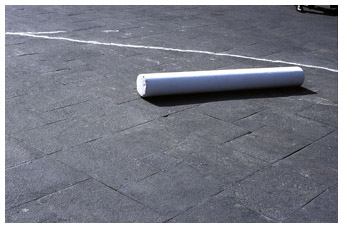


 |


launch interview with Jennifer Allora and Guillermo Calzadilla
Jennifer Allora and Guillermo Calzadilla have been working in collaboration since 1995, frequently mining the spaces between sculpture, performance, architecture, and social or public intervention. In their work they try to provide avenues for reflecting on the complex intersection of global politics and personal identity. Often interactive, their work uses the underutilized (quotes of secret desires placed on flat building rooftops for viewing by airplane passengers), the unexpected (a tennis video-game board painted onto the floor of a real tennis court), and the physical (office window blinds that open and shut according to the movement of outside passersby, thus reorienting who controls the power of observation). Through works infused with a generous democratic impulse, they address issues of public engagement and expression. For the ongoing Chalk Project, the artists place huge pieces of chalk in public spaces such as city plazas and invite people to leave their marks, which range from political protests to whimsical drawings, each a poignant yet ephemeral expression of a specific time, place, and individual within the collective.
For How Latitudes Become Forms, Allora and Calzadilla present Charcoal Dance Floor, a highly detailed floor drawing of animated club-goers in Puerto Rico shown from an aerial perspective. Because the drawing is made with unfixed charcoal adhered to wooden panels, it is a work continually in process, decomposing before our eyes and under our feet. As visitors' footsteps gradually erase the drawing, the exquisite and individualized detail of each figure becomes a blur of gray, hinting at the dangers of conformity and homogeneity in our increasingly globalized world. The construction of identity can be a challenging process for the individual but also a beneficial one for the group when each person's awareness of the other is increased. In making that process visible and physical through their group performances--wherein dancing and erasure symbolize losing one's individual identity for the good of the whole--Allora and Calzadilla aim to increase a community's sense of responsibility by pointing to the consequences and the effects of individual actions. Here, politics and ethics intersect on the dance floor.
Allora and Calzadilla have been featured in solo exhibitions at the Aldrich Museum of Contemporary Art, Ridgefield, Connecticut (2002), and the Institute of Visual Arts at the University of Wisconsin, Milwaukee (2002). They have participated in several group exhibitions, including Zoning at The Project in Harlem, New York (2001); the VII Bienal de La Habana, Havana, Cuba (2000); 1999 at P.S. 1, New York, New York; and the XXIV Bienal de São Paulo, Brazil (1998).
--Olukemi Ilesanmi











